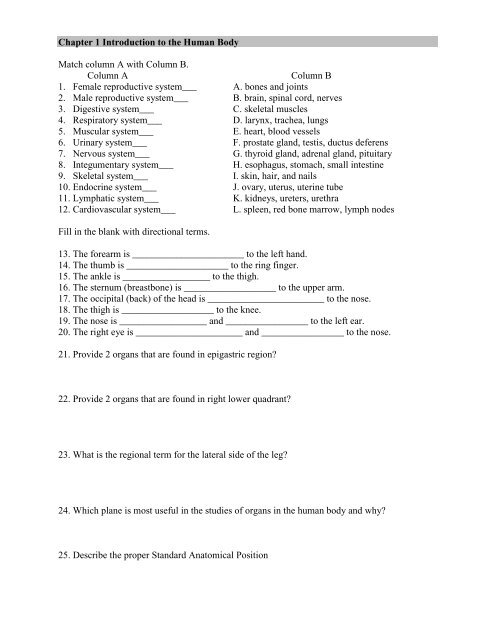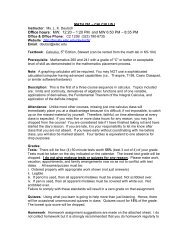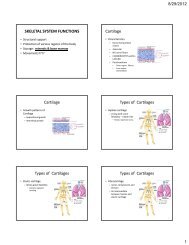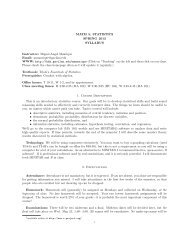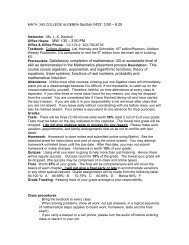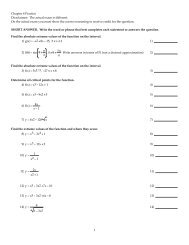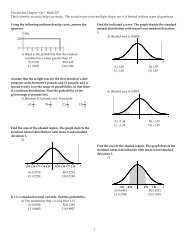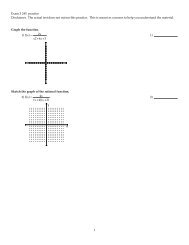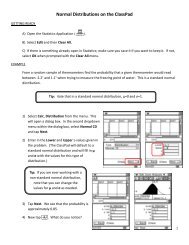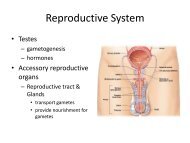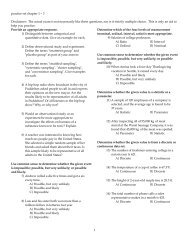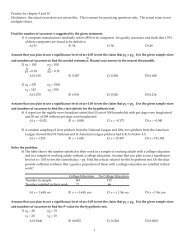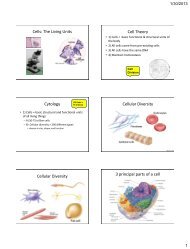Trifecta Anatomy Homework 1 (Ch1,2,4,5)
Trifecta Anatomy Homework 1 (Ch1,2,4,5)
Trifecta Anatomy Homework 1 (Ch1,2,4,5)
You also want an ePaper? Increase the reach of your titles
YUMPU automatically turns print PDFs into web optimized ePapers that Google loves.
Chapter 1 Introduction to the Human Body<br />
Match column A with Column B.<br />
Column A<br />
Column B<br />
1. Female reproductive system___ A. bones and joints<br />
2. Male reproductive system___ B. brain, spinal cord, nerves<br />
3. Digestive system___ C. skeletal muscles<br />
4. Respiratory system___ D. larynx, trachea, lungs<br />
5. Muscular system___ E. heart, blood vessels<br />
6. Urinary system___ F. prostate gland, testis, ductus deferens<br />
7. Nervous system___ G. thyroid gland, adrenal gland, pituitary<br />
8. Integumentary system___ H. esophagus, stomach, small intestine<br />
9. Skeletal system___ I. skin, hair, and nails<br />
10. Endocrine system___ J. ovary, uterus, uterine tube<br />
11. Lymphatic system___ K. kidneys, ureters, urethra<br />
12. Cardiovascular system___ L. spleen, red bone marrow, lymph nodes<br />
Fill in the blank with directional terms.<br />
13. The forearm is _______________________ to the left hand.<br />
14. The thumb is _____________________ to the ring finger.<br />
15. The ankle is __________________ to the thigh.<br />
16. The sternum (breastbone) is ___________________ to the upper arm.<br />
17. The occipital (back) of the head is ________________________ to the nose.<br />
18. The thigh is ___________________ to the knee.<br />
19. The nose is __________________ and _________________ to the left ear.<br />
20. The right eye is ______________________ and _________________ to the nose.<br />
21. Provide 2 organs that are found in epigastric region?<br />
22. Provide 2 organs that are found in right lower quadrant?<br />
23. What is the regional term for the lateral side of the leg?<br />
24. Which plane is most useful in the studies of organs in the human body and why?<br />
25. Describe the proper Standard Anatomical Position
Chapter 2 Cells<br />
1. Draw and label a typical cell with all its structure and organelles.<br />
2. Define the composition and function of the plasma membrane<br />
3. Describe the transcellular transport processes<br />
a. simple diffusion<br />
b. facilitated diffusion<br />
c. primary active transport<br />
d. secondary active transport<br />
e. endocytosis<br />
f. exocytosis
4. Describe the cell theory.<br />
Match column A with column B.<br />
Column A<br />
Column B<br />
1. chromosomes uncoiled and uncondensed___ A. Prophase<br />
2. mitotic spindle forms___ B. Metaphase<br />
3. chromosome are pulled apart___ C. Anaphase<br />
4. cytokinesis occurs___ D. Telophase<br />
5. chromosomes lined up on equatorial plane___<br />
6. nuclear membrane breaks down___<br />
7. centrioles are no longer on opposite side___
Chapter 4 Tissues<br />
Use the key choice to identify the major tissue types described below.<br />
A. Connective Tissue<br />
B. Epithelium<br />
C. Muscle Tissue<br />
D. Nervous Tissue<br />
1. lines body cavities and covers the body’s external surface ___<br />
2. pumps blood, flushes urine out of the body, allows one to swing a bat ___<br />
3. transmits electrochemical impulses ___<br />
4. anchors, packages, and supports body organs ___<br />
5. cells may absorb, secrete, and filter ___<br />
6. most involved in regulating and controlling body functions ___<br />
7. major functions is to contract ___<br />
8. synthesizes hormones ___<br />
9. the most durable tissue type ___<br />
10. abundant nonliving extracellular matrix ___<br />
11. most widespread tissue in the body ___<br />
12. forms nerves and the brain ___
13. Describe and draw the different types of connective tissue NOT the four types of tissues.<br />
CT<br />
Drawing and labeling<br />
Areolar CT<br />
Adipose CT<br />
Reticular CT<br />
Dense regular CT<br />
Dense Irregular CT
CT<br />
Cartilage<br />
Drawing and labeling<br />
Bones<br />
Blood
Chapter 5 The Integumentary System<br />
Using the key choice, choose all responses that apply to the following descriptions.<br />
A. stratum basale D. stratum lucidum G. reticular layer<br />
B. stratum corneum E. stratum spinosum H. epidermis as a whole<br />
C. stratum granulosum F. papillary layer I. dermis as a whole<br />
1. translucent cells in thick skin containg keratin fibrils ___<br />
2. dead cells ___<br />
3. dermal layer responsible for fingerprints ___<br />
4. vascular region ___<br />
5. major skin area that produces derivatives (nails and hair) ___<br />
6. epidermal region exhibiting the most rapid cell division ___<br />
7. scale-like dead cells, full of keratin, that constantly slough off ___<br />
8. mitotic cells filled with intermediate filaments ___<br />
9. has abundant elastic and collagenic fibers ___<br />
10. location of melanocytes and Merkel cells ___<br />
11. area where weblike prekeratin filaments first appear ___<br />
12. region of areolar connective tissue ___<br />
Match the key choice with the appropriate descriptions.<br />
A. arrector pili D. hair follicle G. apocrine sweat gland<br />
B. cutaneous receptors E. nail H. eccrine sweat gland<br />
C. hair F. sebaceous glands<br />
13. produces an accumulation of oily material that is known as a blackhead ___<br />
14. tiny muscles, attached to hair follicles, that pull the hair upright during fright ___<br />
15. perspiration glands with a role in temperature control ___<br />
16. sheath formed of both epithelial and connective tissues ___<br />
17. less numerous type of perspiration-producing gland __<br />
18. found everywhere on the body except the palms of hands and soles of feet ___<br />
19. primarily dead or keratinized cells<br />
20. specialized nerve endings that respond to temperature, touch, etc.<br />
21. its secretion is a lubricant for hair and skin ___<br />
22. “sports” a lunula and a cuticle ___<br />
23. found mainly in the pubic and axillary regions ___<br />
24. Why is the hypodermis not considered part of true skin?


